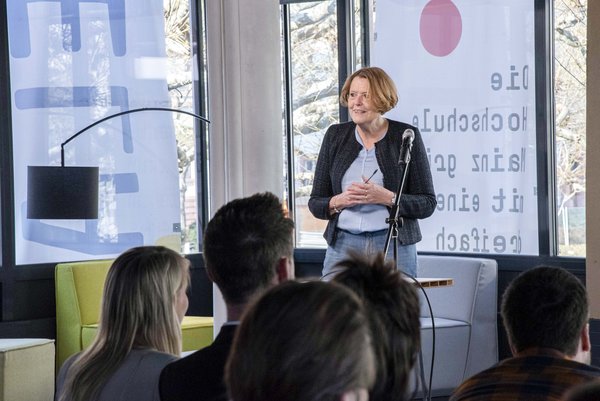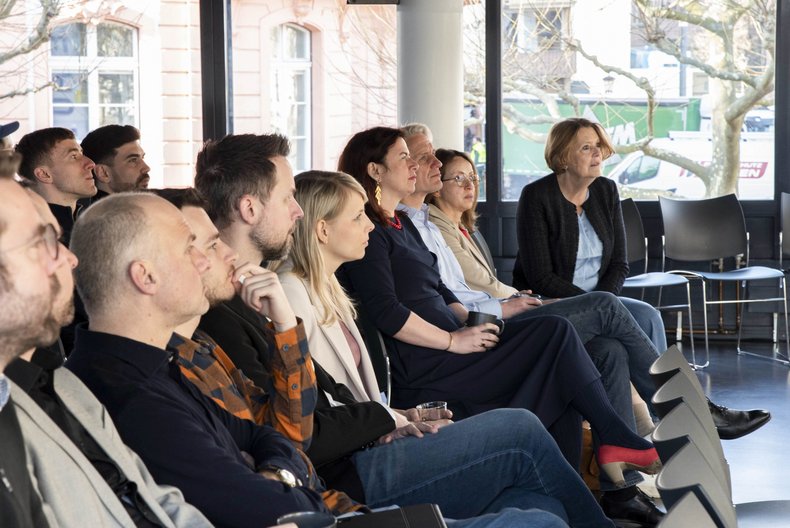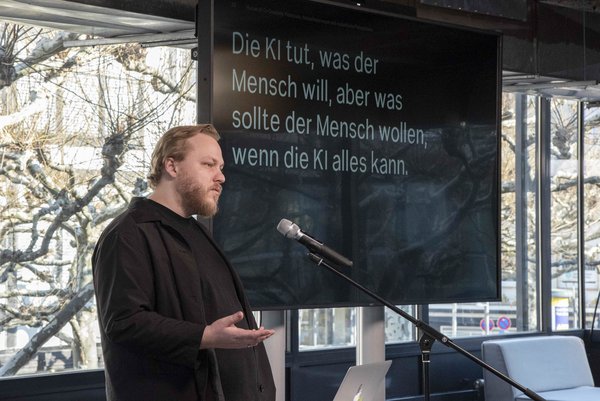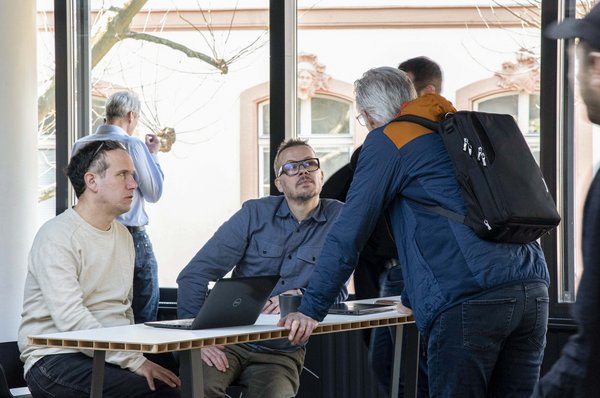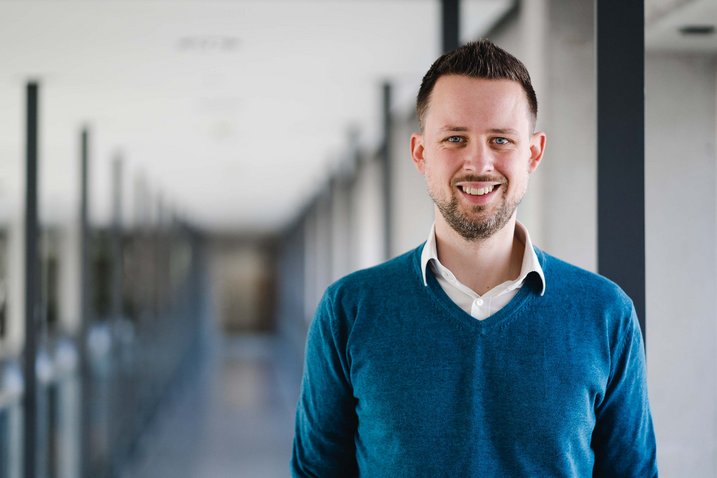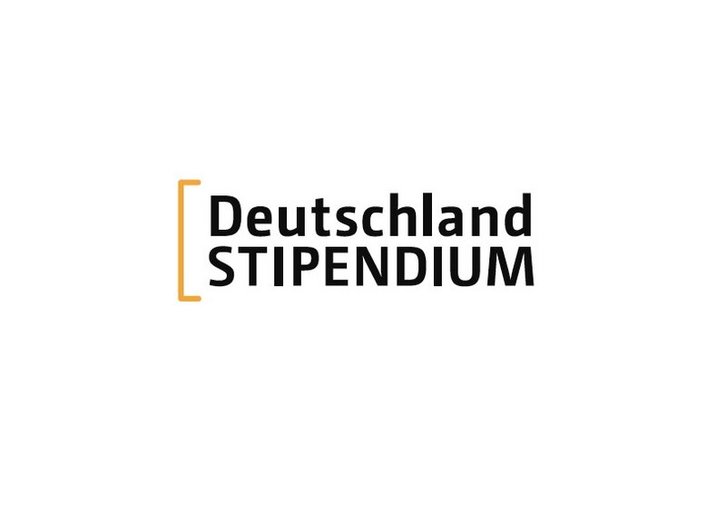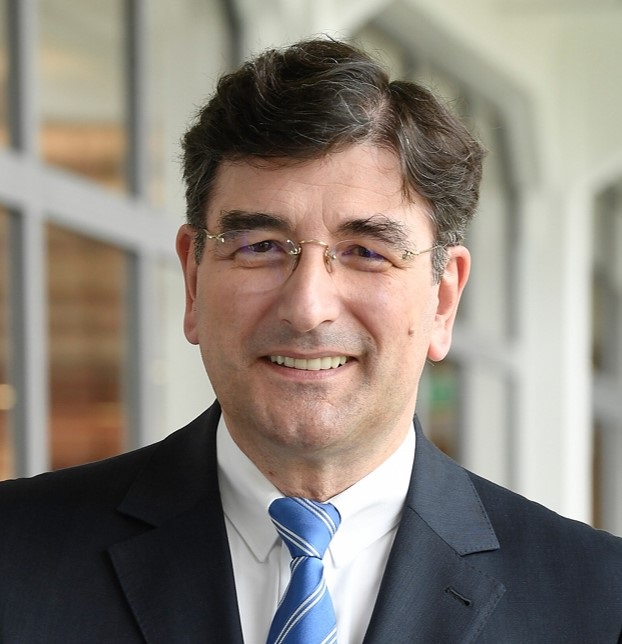On March 6, 2025, Mainz University of Applied Sciences held its second interdisciplinary AI Symposium. The event in the LUX Pavilion brought together experts, researchers, and students to discuss current developments and applications of artificial intelligence (AI). The symposium is part of the “F+T Impulses” (research and transfer impulses) series, which provides a look at the research and transfer activities of Mainz University of Applied Sciences. The event was once again organized under the direction of Prof. Dr. Anett Mehler-Bicher, Vice President, Research and Transfer, who introduced the program with an introductory speech.
The day offered in-depth insights into various AI segments. Prof. Felix Dölker and Prof. Tristan Schulze, both from the School of Design, addressed the creative collaboration between humans and AI and discussed the potential and challenges of this co-creativity with the interested listeners. Prof. Dr. Pascal Neis from the School of Engineering then offered some insights into his experiences with AI-supported tools in teaching and research.
After the first networking break, the innovative research unit AI-DPA was presented. The research unit, which is jointly run by Mainz University of Applied Sciences and the University of Koblenz, is entitled Analyse und Interpretation von unstrukturierten Daten und Prozessen in zwei- und dreidimensionalen Anwendungsszenarien mit Machine Learning (Analysis and Interpretation of Unstructured Data and Processes in Two- and Three-Dimensional Application Scenarios with Machine Learning) and started in January 2024. Jessica Buchner, a doctoral candidate at the School of Engineering, introduced her doctoral project and explained how AI can be used to analyze point clouds in computational visualistics. The area of process mining and machine learning was covered by the teams led by Prof. Dr. Sven Pagel and Flavio Horbach, as well as Prof. Dr. Tobias Walter and Jana Vormann from the School of Business. The focus was on use cases from medicine and the media. Jana Vormann and Flavio Horbach, who presented these case studies, are also working towards their doctorates as part of the AI-DPA research unit.
After the lunch break, Prof. Dr. Sebastian Schlütter from the School of Business, together with research partner Dr. Nico Piatkowski from Fraunhofer IAIS, spoke about the optimization of investment portfolios using hybrid quantum computing. This was followed by a presentation by Prof. Dr. Ulrich Bogenstätter on the topic of sustainable construction entitled “Quick Green Build,” in which he pointed out the relevance of preliminary studies in building information modeling (BIM). In times of climate change, efficient and effective solutions are needed for building analysis, which can be implemented increasingly easily using AI. The NUKOSI process developed by Prof. Bogenstätter and presented at the symposium addresses precisely this issue. In the medical field, Dr. Jean-Jacques Ponciano showed how deep learning is used for the early detection of oral cavity cancers.
The final group of presentations focused on the connection between technology and society through design. Anton Koch and Jean Böhm presented the experimental infrastructure created for AI in design teaching with the multi-university KITeGG teaching and learning platform. Prof. Florian Jenett and David Rittershaus presented the interdisciplinary research activities of Motion Bank. Motion Bank has been combining dance science, software development, and design in various projects since 2016. Two of these projects were presented as examples and illustrated how AI-supported software solutions advance the practice of cultural studies research. The event concluded with Fabian Püschel’s presentation on movement analysis in virtual spaces using pose estimation. Attendees were given a look at the possible applications of the completed Low-Cost-VR-CAVE.
The event offered more than just content-related inspiration; it also provided a platform for exchanging ideas and networking. The day was used to make new contacts and discuss innovative research approaches. The lively discussions showed that there is great interest in the topic of AI and that interdisciplinary cooperation should be fostered even more.
The research and transfer impulses series from the Department of Research and Transfer offers interested professionals the opportunity to learn about the university’s current research topics and exchange ideas with experts. The AI Symposium will take place again next year to continue the dialogue on AI at the university and present the latest developments.
